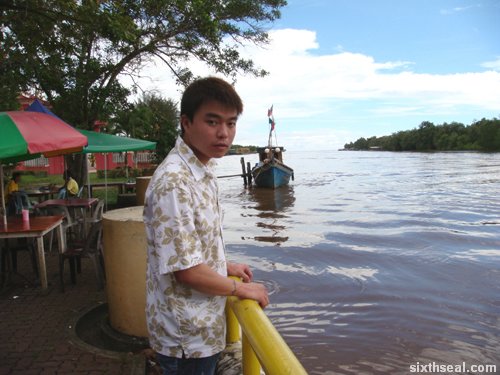
Mukah is a pretty small town but that doesn’t mean it doesn’t have anything to offer besides the infamous sago worms and umai. I stayed at the Kingwood Resort Mukah with Clare, which is about a 14 km distance away from the town. We woke up at around 9 am in the morning, and I read the papers while having my nicotine fix at the balcony before deciding to head down to Mukah.

Unfortunately, the hotel shuttle is currently in transit and the reception informed us that all the taxi drivers are on assignment so I told Clare we’ll just stand by the highway and hitch a ride. I had this idea of using a RM 5 bill (RM 10 if that fails) to flag passing cars to Mukah down. We looked like tourists so I reckon people would be inclined to pick us up. The first car didn’t stop and it started to seem like a bad idea when an SUV saw us and pulled up.

These fine folks were on assignment from HICOM for a Mukah project and was all too happy to drop us off at Mukah. They wouldn’t even accept payment but I insisted, noticing the cigarette packs on the dashboard, to buy them some smokes. It was very kind of them to do that, most people wouldn’t stop but I have faith in The System (TM). 🙂

They dropped us off at Mukah Old Town where the pasar tamu is. This is the central market where you can get umai, sago grubs, tebaloi, and other authentic Melanau produce. The official mascot of Mukah is a fish – Mukah is known for their fresh fish from the sea and fish is their primary export.

I’ve been told that the best method of ensuring that a fish is fresh is to look at the color of the gills.

It may also be necessary to bite off a chunk of fin to verify the freshness of the fish.

I have been learning the arcane arts of camwhoring to limited success too. 😉

The pasar tamu has a lot of stalls selling local produce such as tebaloi, belacan, fish crackers and sago pearls. The kind ladies at the stall were nice enough to show us how sago products are actually made.

Sago comes in a paste form which can be used for cooking various dishes or processed to make other sago products.

Sago pearls are made from sago paste after a baking process. There are different grades and sizes of sago pearls, some of which is eaten with umai and some for cooking.

The famous tebaloi (sago crackers) is a sweet biscuit made of sago flour that has been exported to markets as far as the US and Australia.

Our next stop is to the famous fresh fish market, where the catch of the day is sold straight from the fishing vessels the very same morning.

The stalls were doing brisk business selling everything from barracudas…

…to stingrays.

We met this friendly old man selling stingrays who saw us taking photos and quickly pointed us to the opposite stall where a huge stingray has just being caught and was in the process of being chopped into more manageable portions.

The gigantic stingray was easily the size of a car tire and the man handled the dissection with the ease of one with years of experience, pulling out the innards and chopping the parts into smaller sizes.

We also saw a catch of baby sharks. They look really cute in that size, but I imagine the cuteness factor will disappear when one of them bites your toes off. 😉

Fishing seems to be the favorite pastime of the people of Mukah. It’s done on a large industrial scale with fishing vessels and also on a smaller scale with recreational anglers at the pier.

This is the obligatory “I was here” photo with the Welcome to Mukah sign. Crucified and all I got was this lousy T-shirt. 😉

Mukah is also home to a famous Chinese temple built by the early Chinese settlers in 1879.

I found the statue of a lion with a fatherly paw over it’s cub very adorable. 🙂

The main historical attraction in Mukah is the 20 meter tall chimney from the first sago factory in Mukah. We nearly missed it due to its unassuming facade.

Mukah is a very laid back and relaxed town that is about to be developed into a huge administrative capital from the SCORE project. The town is a little bit far from the resort, but it’s definitely worth the trip, if only to experience the culture and heritage of the Melanau people.